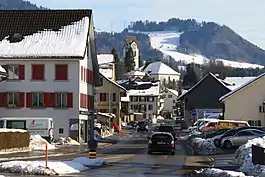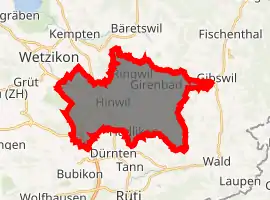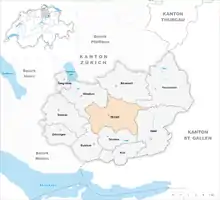Hinwil
Hinwil is a municipality in the district of Hinwil in the canton of Zürich in Switzerland.
Hinwil | |
|---|---|
 | |
 Coat of arms | |
Location of Hinwil 
| |
 Hinwil  Hinwil | |
| Coordinates: 47°18′N 8°51′E | |
| Country | Switzerland |
| Canton | Zurich |
| District | Hinwil |
| Area | |
| • Total | 22.3 km2 (8.6 sq mi) |
| Elevation | 565 m (1,854 ft) |
| Population (2018-12-31)[2] | |
| • Total | 11,135 |
| • Density | 500/km2 (1,300/sq mi) |
| Time zone | UTC+01:00 (Central European Time) |
| • Summer (DST) | UTC+02:00 (Central European Summer Time) |
| Postal code(s) | 8340 |
| SFOS number | 0117 |
| Localities | Girenbad, Hadlikon, Ringwil, Unterbach, Unterholz, Wernetshausen, Bossikon, Erlosen |
| Surrounded by | Bäretswil, Bubikon, Dürnten, Fischenthal, Gossau, Wald, Wetzikon |
| Twin towns | Jablonné nad Orlicí (Czech Republic) |
| Website | www SFSO statistics |



History
The village Hinwil from which the later municipality took its name is first mentioned in 745 as Hunichinwilari, in a donation made by Beata and Landolt to the Abbey of Saint Gall. Hinwil was part of an Alamannic colony comprising also adjoining villages and settlements that were donated during the following century by descendants of Beata and Landolt or by other members of their clan to the same abbey, such as Hadaleihinchova (Hadlikon, donated in 775), Pozinhova (Bossikon, 829), Rimolteswilare (Ringwil, donated together with a church in 837) and Werinholveshusa (Wernetshausen, 867).[3]
The Alamanni were actually preceded by Roman inhabitants, as attested by the foundation walls of a Roman Villa dating from the 1st century CE and detected under the medieval church of Hinwil which is first mentioned in the second half of the 8th century.[3]
During the High Middle Ages, the village Hinwil was part of the Landvogtei of Grüningen and was then, after 1280, subordinated to the commandry of the Knights of St. John at Bubikon. In the process of the Reformation, the governance of Hinwil and other villages of the region was divided between Zürich and the Order of the Knights of St. John, with the influence of the latter being limited by an agreement to use only members of the Reformed Church of Zürich as their local governors.[3]
The economy of Hinwil was originally based on agriculture and rural handcraft. During the second half of the 16th century regional production of linen was introduced, from the 17th century on livestock farming and especially the early modern workshop-system of cloth production came to be dominant and, together with tourism in the wake of the railroad connection established in 1876, provided a certain prosperity in the 19th century and the years before World War I. Industrial production used to play a comparably modest role, yet came to be more important with the local establishment of Bührer Traktorenwerke AG (tractor production, since 1939) and Ferag AG (materials handling namely for newspaper production, since 1957).[3]
Geography

Hinwil has an area of 22.3 km2 (8.6 sq mi). Of this area, 53.9% is used for agricultural purposes, while 26.8% is forested. Of the rest of the land, 17.6% is settled (buildings or roads) and the remainder (1.7%) is non-productive (rivers, glaciers or mountains).[4] In 1996 housing and buildings made up 11.5% of the total area, while transportation infrastructure made up the rest (6.1%).[5] Of the total unproductive area, water (streams and lakes) made up 0.4% of the area. As of 2007 14% of the total municipal area was undergoing some type of construction.[5]
The municipality is located in the Zürcher Oberland on the Bachtel mountain. It was formed in 1798 from the parish of the same name. It includes four independent villages; Hinwil, Ringwil, Wernetshausen and Hadlikon. The hamlets of Bossikon, Erlosen and Girenbad as well as about one hundred individual farms make up the rest of the municipality.
Demographics
Hinwil has a population (as of 31 December 2019) of 11,277.[6] As of 2007, 13.7% of the population was made up of foreign nationals. As of 2008 the gender distribution of the population was 49.7% male and 50.3% female. Over the last 10 years the population has grown at a rate of 9.5%. Most of the population (as of 2000) speaks German (91.1%), with Italian being second most common ( 2.4%) and Albanian being third ( 1.1%).
In the 2007 election the most popular party was the SVP which received 44.7% of the vote. The next three most popular parties were the SPS (13%), the CSP (11.1%) and the FDP (10.4%).
The age distribution of the population (as of 2000) is children and teenagers (0–19 years old) make up 24.6% of the population, while adults (20–64 years old) make up 62.2% and seniors (over 64 years old) make up 13.2%. The entire Swiss population is generally well educated. In Hinwil about 78.5% of the population (between age 25-64) have completed either non-mandatory upper secondary education or additional higher education (either university or a Fachhochschule). There are 3815 households in Hinwil.[5]
Hinwil has an unemployment rate of 1.94%. As of 2005, there were 187 people employed in the primary economic sector and about 77 businesses involved in this sector. 2627 people are employed in the secondary sector and there are 144 businesses in this sector. 3006 people are employed in the tertiary sector, with 399 businesses in this sector.[4] As of 2007 39.4% of the working population were employed full-time, and 60.6% were employed part-time.[5]
As of 2008 there were 2610 Catholics and 4657 Protestants in Hinwil. In the 2000 census, religion was broken down into several smaller categories. From the 2000 census, 54.1% were some type of Protestant, with 50.5% belonging to the Swiss Reformed Church and 3.6% belonging to other Protestant churches. 26.5% of the population were Catholic. Of the rest of the population, 0% were Muslim, 4.9% belonged to another religion (not listed), 2.9% did not give a religion, and 10.8% were atheist or agnostic.[5]
The historical population is given in the following table:[3]
| year | population |
|---|---|
| 1637 | 624 |
| 1794 | 2,112 |
| 1850 | 2,697 |
| 1900 | 2,864 |
| 1950 | 3,623 |
| 1980 | 7,554 |
| 2000 | 9,157 |
Transportation
Hinwil railway station is the terminal station of the Zürich S-Bahn on the line S14. Its train station is a 40-minute ride from Zürich Hauptbahnhof.
Weather
Hinwil has an average of 145.4 days of rain per year and on average receives 1,341 mm (52.8 in) of precipitation. The wettest month is August during which time Hinwil receives an average of 170 mm (6.7 in) of precipitation. During the wettest month, there is precipitation for an average of 14 days.[7]
Economy
Hinwil is the home of the Alfa Romeo Racing F1 Team.
Notable people
- Ueli Maurer (born 1950), Swiss politician, member of the Swiss Federal Council, lives in Hinwil
- Bruno Zuppiger (1952–2016), Swiss management consultant, soldier and politician, lived in Hinwil
- Dany Brand (born 1996 in Hinwil), Swiss athlete specialising in the 400 metres hurdles
References
- "Arealstatistik Standard - Gemeinden nach 4 Hauptbereichen". Federal Statistical Office. Retrieved 13 January 2019.
- "Ständige Wohnbevölkerung nach Staatsangehörigkeitskategorie Geschlecht und Gemeinde; Provisorische Jahresergebnisse; 2018". Federal Statistical Office. 9 April 2019. Retrieved 11 April 2019.
- Hinwil in German, French and Italian in the online Historical Dictionary of Switzerland.
- Swiss Federal Statistical Office Archived 2016-01-05 at the Wayback Machine accessed 06-Aug-2009
- Statistics Zurich (in German) accessed 4 August 2009
- "Ständige und nichtständige Wohnbevölkerung nach institutionellen Gliederungen, Geburtsort und Staatsangehörigkeit". bfs.admin.ch (in German). Swiss Federal Statistical Office - STAT-TAB. 31 December 2019. Retrieved 6 October 2020.
- "Temperature and Precipitation Average Values-Table, 1961-1990" (in German, French, and Italian). Federal Office of Meteorology and Climatology - MeteoSwiss. Archived from the original on 27 June 2009. Retrieved 8 May 2009., the weather station elevation is 540 meters above sea level.
External links
![]() Media related to Hinwil at Wikimedia Commons
Media related to Hinwil at Wikimedia Commons
- Official website (in German)
- Hinwil in German, French and Italian in the online Historical Dictionary of Switzerland.
